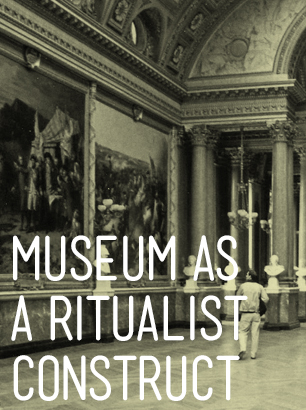Museum as a Ritualist Construct
After a recent personal visit to Louvre and the surrounding museum-city-state, it felt appropriate to tell the story of the emergence of museums and approach this history with a critical eye. For Duncan and Wallach the main critical point of museums is their ideological stance [1]. They point out that, for past societies the places of spectacle that held together the beliefs and values of a society were used to be the temples and cathedrals. Because these places were affirmation of the power and social authority of certain classes, they were lavishly constructed and adorned. Their panache was a show of the stand point of an ideological power.
Duncan and Wallach point out that museums have replaced these architectures as power locations and even go as far to say that “today’s universal survey museum might be compared to Roman displays of war trophies” (p.449). In these context museums become ritualistic locations, sacred locations of art in which visitors are expected to understand, internalize and exalt the values embedded in the shown works. Although different types of museums have emerged in the last few centuries to face the need of different sociological contexts, the universal survey museums survive as the sole heir of the classical tradition, almost to the point that they define what civilization is.
The roots of universal survey museums are traced back to the 18th century when the majority of the art were in the hands of the royalties. Private showings of royal owned art were done in town houses or villas but after the French Revolution the political climate changed to the point that these private aristocratic collections were criticized [2]. Even before French revolution though, many royal collections were being showcased in public locations such as The Glytothek in Munich, Viennese Royal Collection in Vienna, the Dresden Gallery and Uffizi of the Medicis. Yet the establishment of Louvre seems to have changed museum history. The Louvre was aimed to communicate not the majesty of a royalty or King, but the nation. Yet paradoxically, this idea of celebrating the nation was not of the whole nation; just the bourgeois and the educated few. After the revolution though, the path of Louvre became even more clear. The confiscated art of the king needed to be showed somewhere and the new nation/state had to have an uplifting symbol of glory and culture. Then suddenly the universal survey museum also had a mission. It was to be accessible to everyone, it was to be a national monument and it was to nourish the fine tastes of the society and educate them in the ways of art, aesthetics and civilization. Thus the transformation from royal gallery to public art museum has begun. This was a journey from identification of the nation from king’s realm to the state of the people.
The transformation was also one of the physical. The way the artworks were arranged also had to be changed. The works now needed to be arranged by the ideas of the enlightenment, in a fashion that creates a meta narrative about the state and the people (vs the king and the royalty). This also enabled or hastened the birth of an art history discipline, which in turn resulted in a race to possess art from the key moments of history. This also witnessed the birth of an universal value that belonged to the “whole” humanity, a meaning of art and aesthetics that everyone could not grasp but nevertheless was a part of.
For rest of the Europe, of course, the universal museum was a threat as much as the French Revolution. An universal museum that was open to everyone created an illusion of a classless society where each individual was an equal heir to the cultural heritage of “humanity”, an idea of ideal civilization.
Duncan and Wallach elaborate on the experience Louvre offers to its visitors from its main entrance pavilion to the formation of galleries. This emphasis is not unjust since Louvre serves as the template for the original universal survey gallery. Another special attention was given to the architectural adornments of Louvre, especially to the ceiling paintings since their history is also a history of political power in the state. It is concluded that “the Louvre embodies the state and the ideology of the state […] it presents the state not directly but, as it were, disguised in the spiritual form of artistic genius” (p.463).
To conclude this short history of universal museums, one then have to move onto America to rediscover this ritualistic space called the universal survey museum. The idea of such a museum in America was a mixture of post-Civil War ideologies, as well as issue of national pride. As United States emerged as a nation-state, its claim on the western civilization became also apparent. Yet America had the distinct disadvantage of joining the race late, as many of the relics of traditional western civilization had already found their places in Europe (this seems to be the apparent reason why New York would later become a global center for modern art). The result was the Metropolitan. It is possible to define the Metropolitan as a monument of imperialist ideology; a ritualistic construct where an art history emerged as a façade of the real history of the state – much like its European predecessors.
[1] Carol Duncan and Alan Wallach, “The Universal Survey Museum”, ed. Bettina Messias Carbonell, Museum Studies – an Anthology of Contexts (Oxford: Blackwell Publishing, 2004).
[2] Holger Hoock, “Reforming Culture: National Art Institutions in the Age of Reform”, ed. Joanna Innes and Arthur Burns, Rethinking the Age of Reform: Britain 1780-1850 (Cambridge: Cambridge Press, 2007).



Leave a Reply
You must be logged in to post a comment.